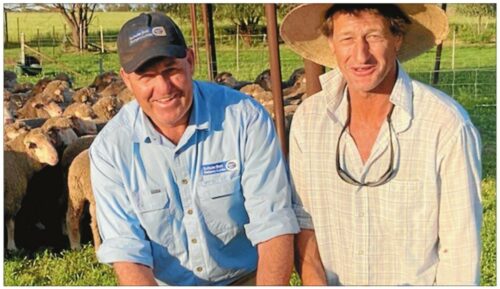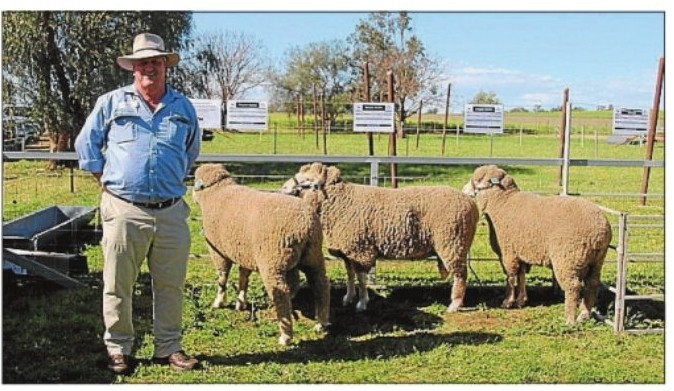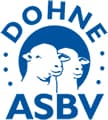Influence is expanding
Breed is behind great advances
“The structure of the Dohne has improved and the quality is fairly consistent right through the breed because breeders have set a standard and because of that they are using trained assessors, which means everybody is on the same page and they are establishing consistency.”
BY ALAN WELBURN ACM Newspapers
DOHNE sires are lifting fertility, lamb survival and lamb growth rates, boosting productivity for NSW lamb and wool producers.
Ian Goddard, Schute Bell lnverell, has been in the sheep industry for more than 25 years and has a client base which covers South East Queensland and the New England and North West regions of NSW.
He’s supported many producers in making on farm transitions to achieve maximum productivity and Dohnes play a big role in this with improved fertility lifting lambing percentages.
“The regions I deal with daily are traditionally Merino-based areas, with very few crossbreds in the mix,” Mr Goddard said.
“In saying this, over the past few years the Dohne have really developed their fertility and size and as a result, a number of my clients, who have been traditional Merino breeders, have turned to the Dohne.
“This shift has been largely due to the Dohne’s strength in fertility and ability to produce a better first-cross lamb.”
Mr Goddard said breeders were responsible for doing a good job to improve the structure of the Dohne.
“The structure of the Dohne has improved and the quality is fairly consistent right through the breed because breeders have set a standard and because of that they are using trained assessors, which means everybody is on the same page and they are establishing consistency.” Mr Goddard said
“Having achieved traits in fertility and size, I believe a lot of studs are now placing a heavy focus on making them an even more reliable wool-producing breed.
“This is something that will solidify them as the go to dual purpose sheep that won’t see producers have to compromise and that can only have positive outcomes for everyone.”
Mr Goddard said many of his clients were recording good wool clip with an improvement to higher returns.
“There has been a real turnaround in the past few years,” he explained.
“There has been more emphasis put into wool production.
“Its wasn’t so long ago a good client of mine told me his commercial ewes were producing at 18.4 micron wool and yielding 77.5 percent to make 1577 cents a kilogram and their stud ewes came in at 19.3 micron, yielding 76.9pc and making 1202c/kg.
“Those figures back up what Dohnes can do and these sheep can cut 5kgs of wool an average.”
Similar strong results are evident among the lamb producers, according to Chris Clemson, Clemson & Hiscox Walgett.
Mr Clemson said about 15 years ago, Merino producers were struggling to meet market specifications, particularly weight, with their lambs.
The Dohne has not only improved on-farm productivity with increased fertility and no flystrike issues, but the breed has been instrumental in helping lift lamb growth rates, making them able to meet trade weights at an early age, he said.
“Generally, our Dohne lambs will average between 24kg and 27kg carcase weight, which is on average about 4kg to 5kg heavier than what we’re getting out of the Merinos,” Mr Clemson said.
“In some cases, Dohnes are up to 7kgs or even 8kgs heavier.
“We are seeing lot bigger carcases in our older sheep and just a little while back I processed some ewes at
35.58kgs and got $6/kg.
“They were just off the shears so it was a good result all round.
“They got a couple of dollars for the skins and came back with a total of $215. Their dressed weight is much higher than others and it’s similar with the young lambs.”
Longevity is another trait of the Dohne.
“A couple of years ago I sold some ewes for a bloke, which we had bought for him five years earlier for $100 as five-year-old,” Mr Clemson said.
“He had them for a full five years but we processed them at 28kg as 10-year old and they got close to $200 each.
“They do very well.
“Just as importantly the lambs are very good survivors and they are much cleaner in the breech and head and because of those features, you find management is a lot easier with the Dohne than others.
“All things considered they are pretty good all round sheep and will only get better.”

GOOD TYPES: Ian Goddard, pictured with John Nadin, says the structure of the Doh ne has improved and the quality is fairly consistent throughout the breed.

WISE WORDS: Chris Clemson, Clemson & Hiscox Walgett, has first-hand accounts of good growth in Dohnes and can foresee a bright future for the breed.










 Facebook
Facebook YouTube
YouTube Instagram
Instagram